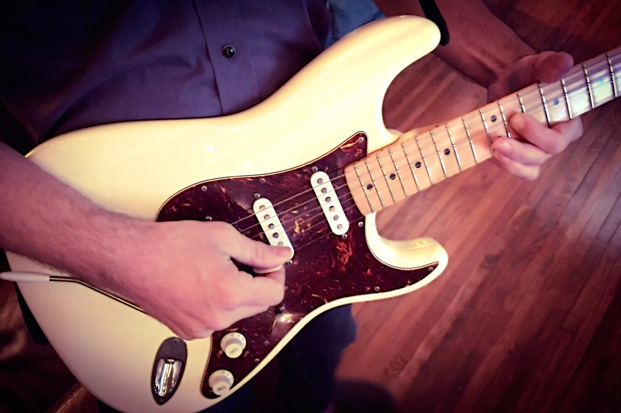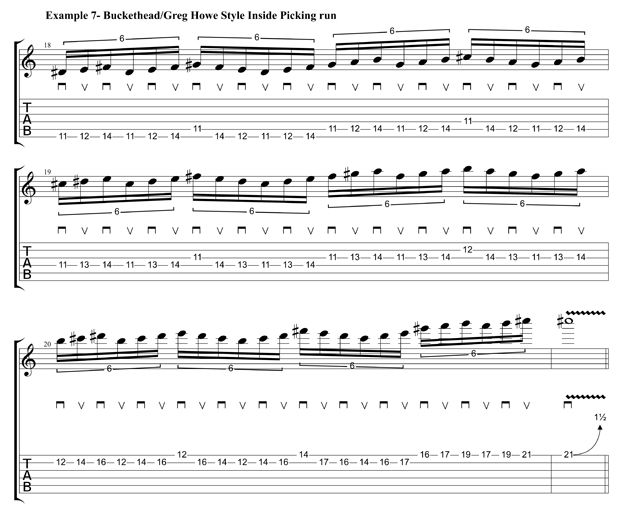The Ins and Outs of Supersonic Alternate Picking

New students are always coming to me asking, “How do I improve my sloppy, inaccurate, clumsy and slow picking technique?”
More often than not, the first thing I notice about their playing is that they employ an unpolished technique that lacks the discipline of a steady, consistent and controlled use of strict alternate picking.
What I find with these students, especially those who were previously self-taught, is that their technique is a haphazard (yet sometimes logical) combination of alternate, economy and awkward sweep picking.
While being skilled at economy picking and sweep picking is essential in every guitarist’s bag of tricks, I find that these students are not performing these techniques deliberately, but instead as an accidental consequence of dealing with the tricky nature of crossing from string to string when dealing with 1-per or 3-note-per-string style phrasing patterns.
The “tricky” bit that seems to trip these students up comes when specific mechanical movements come into play, specifically those found when crossing from a lower-pitched string with a downstroke to a higher-pitched string with an upstroke (“outside” picking), and when crossing from a higher-pitched string with a downstroke to a lower-pitched string with an upstroke (“inside” picking).
The following examples are exercises and licks I have found will clean up any guitarist’s picking technique and give them the control and accuracy to greatly improve their ability to achieve the speed and fluidity they desire. Though there are exceptions to this rule, for the sake of these exercises, make sure the alternating pick strokes are accomplished with firm, yet relaxed grip of the pick and a rotation of the pick hand wrist similar to that of turning a key in a door.
EXAMPLE 1A shows “outside” picking at its most basic. After picking down on the B string, you’ll swing back around, to the outside of the high E string, and strike the string with an upstroke, swinging back around the outside of the B string and striking it with a downstroke, etc. EXAMPLE1B is the opposite, “inside” picking, going down on the high E and coming back up inside the E and B with an upstroke on the B.
All the latest guitar news, interviews, lessons, reviews, deals and more, direct to your inbox!

Most guitarists I encounter with problem pick technique usually have no difficulty using strict alternate picking with pentatonic derived lines, as more often than not they are using a downstroke when going to a new string, regardless of whether going upwards or downwards on the strings, so to get them used to the adjustment of crossing strings with more complex scale patterns, I often have them perform the simple three-note per string pattern in EXAMPLE2A.
The simplicity of the fingering pattern will allow for focus on the “swing” of the pick hand. EXAMPLE 2B is similarly simple as far as the fingering, but many students find that the inside picking motion slows them down.

In the case of any difficulty with either variation, stick with it! Practice slowly and methodically at first with a metronome, focusing on coordination of rhythmic fretting and a well-timed rotation of the wrist. Also note that in each exercise, every new beat begins on a downstroke, so let the physicality of the rhythm guide you and slightly emphasize each beat to help create thrust throughout the pattern.
In a similar vein but more focused on pure speed mechanics, EXAMPLES 3A and 3B are inspired by the “Paul Gilbert Exercise,” running a four-note pattern in a circle. Note that while the notes are the same, the rhythmic shift of where the downstrokes are changes the feel of the pattern dramatically (and the “snap” of the high E on the beat in EXAMPLE 3B can be addictive at high speeds!).

The next obvious step is to combine the two styles of picking into one line/exercise. EXAMPLES 4A through 4D are variations on these combinations using two different six-note patterns in each loop. EXAMPLE 4A goes up Pattern 1 and down Pattern 2, EXAMPLE 4B goes down Pattern 1 and up Pattern 2, EXAMPLE 4C goes up Pattern 2 and down Pattern 1, and EXAMPLE 4D goes down Pattern 2 and up Pattern 1.
Other than the obvious differences in the fingering and picking of each of these, pay attention to the relativity between their melodic contour and the relation to their respective beats. Practiced properly, each of these will have dramatically different feels! Be sure to try variations like this with some of your favorite practice patterns and licks.


EXAMPLE 5 demonstrates the concept of combining both inside and outside picking in a real world scenario. This Gus G-style “solo crescendo” lick combines three different shapes in an expanded loop in Dm, shifting positions with each beat.

So far the examples have dealt with repetitive patterns on two strings, but the Paul Gilbert-inspired EXAMPLE 6 takes outside picking further in a connective pattern ascending across all six strings. In this case, the pattern expands beginning on the low E, then the A, then the D, etc., culminating in an Am arpeggio beginning with a tapped C note at the 20th fret on the high E and then continuing through the arpeggio with pull-offs and sweep picking.
This maneuver, and the alternate picked notes on the A string at the end of the phrase, will greatly emphasize your overall control of your picking, as you’ll find that momentum can be difficult to overcome when you switch techniques.

Finally, EXAMPLE 7 works a Buckethead/Greg Howe-style ascending E major (D# Locrian fingering) pattern emphasizing inside picking. As with the previous example, this example once again focuses on controlling momentum, rising to a crescendo by shifting the angle of the pattern from vertical to horizontal.

All players, regardless of their skill level can benefit from breaking down and focusing on the mechanics of their alternate picking technique. Beginners and intermediates will get the most benefit by practicing the above exercises with a metronome and focusing on rhythmic accuracy and finger articulation with the goal of relaxed speed, moving the picking patterns into any scale patterns they know, and advanced players should expand the patterns mathematically across the fretboard and/or increase the difficulty of the exercises by incorporating string skipping.
Happy shredding!
Scott Marano has dedicated his life to the study of the guitar, honing his chops at the Berklee College of Music under the tutelage of Jon Finn and Joe Stump and working as an accomplished guitarist, performer, songwriter and in-demand instructor. In 2007, Scott developed the Guitar Strength program to inspire and provide accelerated education to guitarists of all ages and in all styles through state-of-the-art private guitar lessons in his home state of Rhode Island and globally via Skype. Learn more at GuitarStrength.com.
Scott Marano has dedicated his life to the study of the guitar, honing his chops at the Berklee College of Music under the tutelage of Jon Finn and Joe Stump and working as an accomplished guitarist, performer, songwriter and in-demand instructor. In 2007, Scott developed the Guitar Strength program to inspire and provide accelerated education to guitarists of all ages and in all styles through state-of-the-art private guitar lessons in his home state of Rhode Island and globally via Skype.
